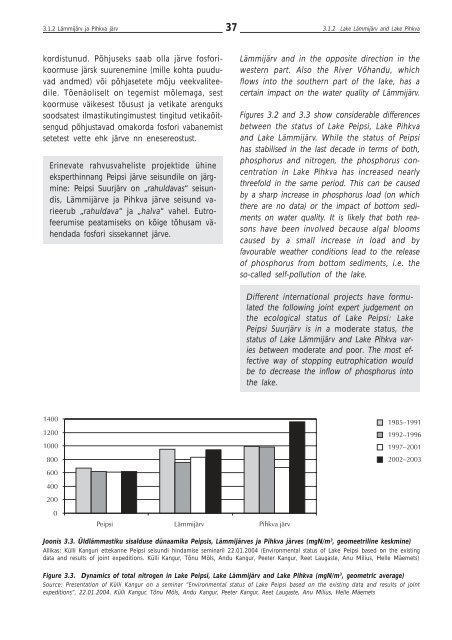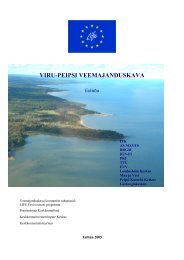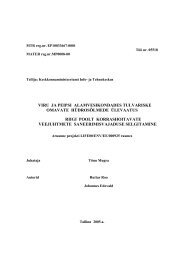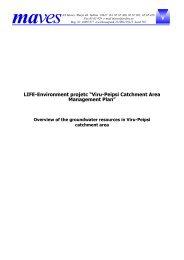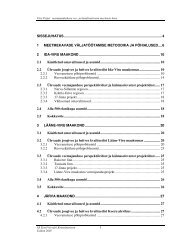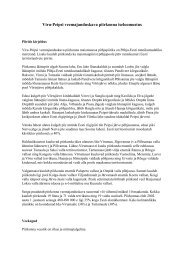Viru-Peipsi veemajanduskava - Keskkonnaministeerium
Viru-Peipsi veemajanduskava - Keskkonnaministeerium
Viru-Peipsi veemajanduskava - Keskkonnaministeerium
You also want an ePaper? Increase the reach of your titles
YUMPU automatically turns print PDFs into web optimized ePapers that Google loves.
3.1.2 Lämmijärv ja Pihkva järv<br />
37<br />
3.1.2 Lake Lämmijärv and Lake Pihkva<br />
kordistunud. Põhjuseks saab olla järve fosforikoormuse<br />
järsk suurenemine (mille kohta puuduvad<br />
andmed) või põhjasetete mõju veekvaliteedile.<br />
Tõenäoliselt on tegemist mõlemaga, sest<br />
koormuse väikesest tõusust ja vetikate arenguks<br />
soodsatest ilmastikutingimustest tingitud vetikaõitsengud<br />
põhjustavad omakorda fosfori vabanemist<br />
setetest vette ehk järve nn enesereostust.<br />
Erinevate rahvusvaheliste projektide ühine<br />
eksperthinnang <strong>Peipsi</strong> järve seisundile on järgmine:<br />
<strong>Peipsi</strong> Suurjärv on „rahuldavas“ seisundis,<br />
Lämmijärve ja Pihkva järve seisund varieerub<br />
„rahuldava“ ja „halva“ vahel. Eutrofeerumise<br />
peatamiseks on kõige tõhusam vähendada<br />
fosfori sissekannet järve.<br />
Lämmijärv and in the opposite direction in the<br />
western part. Also the River Võhandu, which<br />
flows into the southern part of the lake, has a<br />
certain impact on the water quality of Lämmijärv.<br />
Figures 3.2 and 3.3 show considerable differences<br />
between the status of Lake <strong>Peipsi</strong>, Lake Pihkva<br />
and Lake Lämmijärv. While the status of <strong>Peipsi</strong><br />
has stabilised in the last decade in terms of both,<br />
phosphorus and nitrogen, the phosphorus concentration<br />
in Lake Pihkva has increased nearly<br />
threefold in the same period. This can be caused<br />
by a sharp increase in phosphorus load (on which<br />
there are no data) or the impact of bottom sediments<br />
on water quality. It is likely that both reasons<br />
have been involved because algal blooms<br />
caused by a small increase in load and by<br />
favourable weather conditions lead to the release<br />
of phosphorus from bottom sediments, i.e. the<br />
so-called self-pollution of the lake.<br />
Different international projects have formulated<br />
the following joint expert judgement on<br />
the ecological status of Lake <strong>Peipsi</strong>: Lake<br />
<strong>Peipsi</strong> Suurjärv is in a moderate status, the<br />
status of Lake Lämmijärv and Lake Pihkva varies<br />
between moderate and poor. The most effective<br />
way of stopping eutrophication would<br />
be to decrease the inflow of phosphorus into<br />
the lake.<br />
Joonis 3.3. Üldlämmastiku sisalduse dünaamika <strong>Peipsi</strong>s, Lämmijärves ja Pihkva järves (mgN/m 3 , geomeetriline keskmine)<br />
Allikas: Külli Kanguri ettekanne <strong>Peipsi</strong> seisundi hindamise seminaril 22.01.2004 (Environmental status of Lake <strong>Peipsi</strong> based on the existing<br />
data and results of joint expeditions. Külli Kangur, Tõnu Möls, Andu Kangur, Peeter Kangur, Reet Laugaste, Anu Milius, Helle Mäemets)<br />
Figure 3.3. Dynamics of total nitrogen in Lake <strong>Peipsi</strong>, Lake Lämmijärv and Lake Pihkva (mgN/m 3 , geometric average)<br />
Source: Presentation of Külli Kangur on a seminar “Environmental status of Lake <strong>Peipsi</strong> based on the existing data and results of joint<br />
expeditions”, 22.01.2004. Külli Kangur, Tõnu Möls, Andu Kangur, Peeter Kangur, Reet Laugaste, Anu Milius, Helle Mäemets


